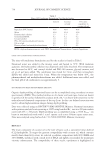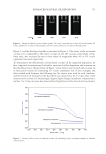695 MOISTURE IN THE CUTICLE SHEATH cuticle cells appeared in a flat position, as if they were cemented like normal cuticle cells. However, as will be discussed later, this is just a superficial change, as the cement had been broken before, and, therefore, the apparent normal cells were readily lifted again by solvent dehydration. For instance, videorecording analysis showed that when these fibers were immersed in isopropyl alcohol (IPA), the apparently normal-looking cuticle cells immediately lifted and buckled again. It should be mentioned here that real normal cuticle cells (i.e., ones not previously decemented) did not show such lifting behavior upon IPA immersion. The phenomenon of cuticle cell lifting and buckling with IPA can be explained by considering the fact that such a solvent dehydrates the endocuticles of apparently normal looking cuticle cells, causing them to contract, lift, and buckle again. This important observation confirms that the protein structure of the endocuticle behaves like a hydrated gel, which contracts as it loses water, causing cuticle cell buckling once the cement is broken. CUTICLES CELLS ARE NOT SENSITIVE TO MOISTURE EVAPORATION So far, enough evidence has been presented indicating that the shape of most cuticle cells in hair fibers is sensitive to moisture. However, during the experimental analysis, it was often found that some cuticle cells do not change shape by either dehydration or rehydration. For instance, the videorecording technique showed that while there are regions of cuticle cells that rapidly undergo lifting and buckling by thermal dehydration during blow drying and elongation, there were also other regions where the cuticle cells did not change shape at all. This observation was true even for long periods of blow drying. Likewise, some cuticle cells that had been de-cemented and buckled either by high elongations or thermal stresses did not recover their shape when hydrated even after long periods of water immersion. Both observations point toward a lack of responsiveness to moisture changes in the cuticle cell. Such a phenomenon indicates the possibility that proteins in the endocuticle of these cuticle cells lost their native structure in a process akin to denaturation. It could also be that other structures in the cuticle cell layers were mechanically denatured or damaged. CONCLUSION The experiments discussed above indicate that the mechanical properties and damage patterns of hair cuticle cells are not only sensitive to their moisture content but also to its rate of evaporation. In addition, the results also indicate that in its undamaged form, the endocuticle, exocuticle, and CMC protein structures have a balanced moisture distribution, which allows them to work as an assembly in the transfer of mechanical stresses, providing resistance to damage. The analysis also indicates that cuticle cell buckling can be produced by either only mechanical stresses or by a combination of mechanical and thermal stresses. Two patterns of cuticle cell thermomechanical buckling could be distinguished, namely, endocuticular and exocuticular. Both seem to be driven by transient dehydration of the endocuticle and to a certain extent of the exocuticle. The former is characterized by rupture of the CMC cementing top cuticle cells to those immediately underneath, while the second is characterized by the rupture of the cement between exocuticle and endocuticle. Finally, the results also suggest that the endocuticular protein structure behaves like a hydrogel, which interchanges moisture with the environment.
696 JOURNAL OF COSMETIC SCIENCE REFERENCES (1) J. M. Marsh, A. Schwan-Jonczyk, M. G. Davis, and S. W. Slofel, Consumer Perception versus Single and Bulk Fiber Technical Measurement, Weimar, Germany, 2009 International Hair Science Symposium. (2) C. R. Robbins. Chemical and Physical Behavior of Human Hair. 3rd Ed. Springer-Verlag, New York, 1994. (3) L. Kreplak, C. Merigoux, F. Briki, D. Flot, J. Doucet, Investigation of Human Hair Cuticle Structure by Microdiffraction: Direct Observation of Cell Membrane Complex Swelling, Biochim. Biophys. Acta., 1547(2), 268–274 (2001). (4) M. Gamez-Garcia, Cuticle De-cementation and Cuticle Buckling produced by Poisson Contraction on the Cuticular Envelope of Human Hair, J. Soc. Cosmet. Chem. 49, 213–222 (1998). (5) M. Gamez-Garcia, Patterns of Light Interference Produced by Damaged Cuticle Cells in Human Hair, J. Cosmet. Sci., 58(4), 269–282 (2007). (6) M. Gamez-Garcia, The Effects of Lipid Penetration and Removal from Subsurface Microcavities and Cracks at the Cumin Cuticle Sheath, J. Cosmet. Sci., 60(2) 85–95 (2009). (7) M. Feughelman, Mechanical Properties and Structure of Alpha-Keratin Fibers, Wool Human Hair and Related Fibers. University of New South Wales Press, Sydney, 1997.
Purchased for the exclusive use of nofirst nolast (unknown) From: SCC Media Library & Resource Center (library.scconline.org)






































































































































